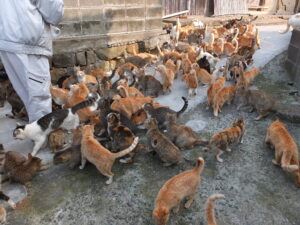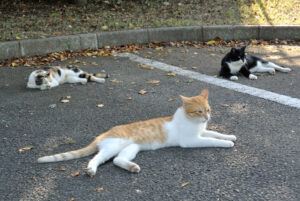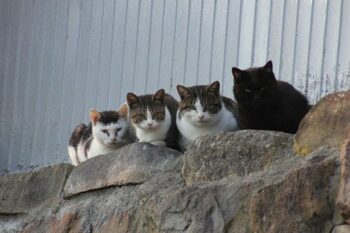Have you ever heard of Aoshima, Japan’s cat island? Find this one mile long island in the Ehime Prefecture of southern Japan. On this island, cats rule, as they outnumber the human population by at least 10 to 1.
Why Aoshima Was Settled

Aoshima started as a fishing village, supported by the sardine trade. By 1945, the population of the small bit of land had grown to around 900 residents.
Just as in ancient Egypt, the fishermen adopted cats as rodent destroyers on their vessels. Then, when the cats came ashore on Aoshima, they earned food and great treatment because they had an important job to do. Besides, people found them endearing. Because these cats received food and care, they became friendly.
The Dwindling Sardine Supply Changed Things
However, the sardine supply declined, and more and more residents had no choice but to leave to find jobs. Only a few older residents decided to remain. In 2019 the population had dwindled to only six people. As folks moved from the island, many left their cats behind. Thus, the feline population between 2015 and 2019 ranged from 120 to 130 cats.
In February of 2018, the Ehime Shimbun reported that a TNR program (Trap, Neuter, Return) mandated that all the cats on the island would be spayed and neutered. In this way, the Japanese hoped to lower the feline population to correspond with the declining human population.
Through this program, most of the cats received the TNR treatment. However, a few cats didn’t go through the program because at least one old resident who opposed the program hid some of the cats.
Are These Cats Friendly?
The cats on Aoshima Island do not fear humans, as they are used to people visiting and feeding them. Though friendly and liking attention and petting, they remain a bit untamed and will not let you pick them up and carry them around
them. Though friendly and liking attention and petting, they remain a bit untamed and will not let you pick them up and carry them around
However, they will stay close to you and follow you around to see if you have any treats. If you visit and bring cat snacks, remember that you may only feed the cats in designated feeding areas. Residents request that you follow this local custom.
Aoshima, Not Your Typical Tour Destination
Yes, you can visit Aoshima. However, remember that this spot does not meet the requirements of a traditional tourist spot. Limited numbers of people arrive on any given day, dependent on the number of passengers allowed on the ferry boat, which can only carry around 34 people.
The ferry makes just two round trips per day, and only stays on the island for an hour or two. Once you arrive, you will find no restaurants or even snack machines. You will also learn that the island has no overnight accommodations.
You can bring food and drinks with you, but you must make sure to take all trash back with you when you leave. You will find no public transportation, no rental cars, and no bikes. You must wear comfortable walking shoes.
What To Expect When You Visit
Be prepared to see many cats and very few residents. Any other people you see are most likely tourists. Be sure to bring some small treats to feed the cats. You will find they are not picky eaters. Though local residents take on the responsibility of feeding all these cats, you are allowed to bring them some extras.
If you have cat goodies for them, be sure you feed them in the designated feeding areas. Give a single cat a small treat only.
single cat a small treat only.
As the island has no public buildings, be aware that if you open a door, most likely you are about to enter someone’s home. Though residents welcome guests, they prefer that you leave them alone. When you visit, do not hang around the port, as you may obstruct the delivery of important supplies and mail.
Are You In Good Shape For Your Walking Tour?
If you decide to visit, make sure your physical condition will allow you to walk around the island. As you will find no cars or bikes, you must rely on your feet. Also, when visiting in the summer, you might be glad for an umbrella for shade or a cool drink to refresh you.
Why Are The Japanese So Fascinated With Cats?
You will find documentation of Japan’s fascination with cats throughout their history. Numerous volumes of artwork feature cats as the main subject. The felines even appear on feudal ukiyo-e, a genre of Japanese art produced on woodblock prints and paintings.
These date as far back as 1603. This genre of art often displays scenes from history and folklore. From these art displays, one may deduct that the cats have a relatively positive reputation, and the Japanese consider them as protectors and bringers of good fortune.
Here is a video view of Aoshima and its cats.
In Manami Okazaki’s latest book, Land of the Rising Cat, he explores some of the reasons behind Japan’s long interest in this small animal. He suggests that “cats are compassionate toward us, and sensitive…This kind of relationship might suit contemporary times.”
It seems that some Japanese come to consider cats as a kind of surrogate offspring. Also, with more people moving to cities, they often see cats as better companions, as the animal retains its independent nature and requires a smaller living space than a dog.
Japanese find them charming as well as being “childlike,” including their typical lazy behavior. Most cats have mastered this way of being.
Aoshima — A Cat Lover’s Paradise
 If you are a cat lover, you might consider putting this island on your bucket list. Where else will you find a place where so many cats gather, with so few human inhabitants? You might find it a refreshing change from other popular tourist spots you have visited.
If you are a cat lover, you might consider putting this island on your bucket list. Where else will you find a place where so many cats gather, with so few human inhabitants? You might find it a refreshing change from other popular tourist spots you have visited.
References I Used For This Post:
I first learned about Aoshima from the blog on nyxycat.com, and have used material from this blog for the backbone of my post. Go to nyxycat.com/blogs/nyxycat-blog/where-is-aoshima-island
Other references:
en.wikipedia.org/wiki/Aoshima,_Ehime
rove.me/to/japan/aoshima-cat-island
https://www.localiiz.com/post/travel-tips-inspiration-japan-aoshima-tashirojima-famous-cat-islands


That would certainly be a fascinating place to go for those who could travel, and who could manage the particular travel conditions the island requires.
I find it interesting that the population seems to have a high number of orange cats in relation to those of darker colors. There appear to be many more orangies than I’ve seen in other random bred populations over my lifetime. That is of course just an informal and casually observed impression. I could easily be entirely wrong . . .
I noticed the many orange cats, too. It would be interesting to know how that came about. There must have been more orange cats to begin with, and they multiplied faster.
It would certainly be a fun place to visit. There are other cat islands in Japan — perhaps someone should plan a tour of those islands for folks who are really into cats. I think if I visited, I’d take a pup tent and spend a night or two. I wonder if such is allowed.